The Critical Role of Timely Pediatric Dental Visits
Early oral health care in children is foundational to preventing dental diseases and promoting overall well-being. National health organizations uniformly recommend the first dental visit by the age of one to establish a dental home, ensure timely preventive care, and educate caregivers. This article presents key statistics and insights on the timing of first dental visits, common pediatric dental diseases, the impact of early intervention, and strategies for promoting optimal oral health in young children.
The Importance of Early Pediatric Dental Visits for Children's Oral Health
What is the significance of early pediatric dental visits for children's oral health?
Starting dental visits early, ideally by the child's first birthday, plays a critical role in establishing a foundation for lifelong oral health. These visits allow dentists to monitor the growth of teeth and jaw development, identify potential issues early, and implement preventive measures. Establishing a dental home creates a familiar environment that reduces anxiety and encourages positive attitudes toward dental care.
Oral health benefits of early visits
Children who have their first dental appointment by age one are more likely to continue regular check-ups, which help prevent dental caries—the most common childhood disease—affecting over half of all children. Early interventions such as fluoride varnish, sealants, and early detection of problems can arrest decay before it worsens. These preventive strategies greatly diminish the need for invasive treatments later and are associated with lower dental costs.
Long-term impact of early dental interventions
Research indicates that children receiving early dental care tend to have better oral health outcomes over time. They experience fewer cavities, less pain, and fewer emergency visits. Early counseling on proper oral hygiene and diet habits, combined with professional preventive care, promotes healthy development of teeth and gums, reducing the likelihood of costly treatments in the future.
Preventing dental caries and diseases
Prevention is at the core of early dental visits. These appointments help identify early dental lesions that can be treated with nonsurgical methods like fluoride applications or silver diamine fluoride. Educating parents about minimizing sugar intake and proper brushing techniques further protects against cavity development.
Promoting positive dental experiences for children
Visiting the dentist early fosters comfort and familiarity, helping children develop positive attitudes toward oral care. Children are less likely to develop dental anxiety or fear when they have positive early experiences. This proactive approach encourages ongoing dental attendance and better compliance with oral health routines.
Parental education during early visits
Early appointments serve as an educational opportunity for parents, emphasizing the importance of oral hygiene, healthy eating, and regular check-ups. Parents learn how to clean gums before teeth erupt, the significance of avoiding prolonged bottle use, and how to recognize early signs of dental issues. This knowledge empowers families to maintain good oral health at home and seek timely dental care.
| Aspect | Benefits | Additional Details |
|---|---|---|
| Timing | By age 1 | Promotes early detection, reduces fear |
| Prevention | Fluoride, sealants | Less invasive, cost-effective |
| Education | Parental guidance | Establishes healthy habits early |
| Outcomes | Reduced decay, emergency visits | Long-term oral health improvement |
Early pediatric dental visits are essential not only for preventing disease but also for shaping a positive oral health future. They improve access to care, lower costs, and support overall child development.
Timing of the First Dental Visit: Recommendations and Guidelines
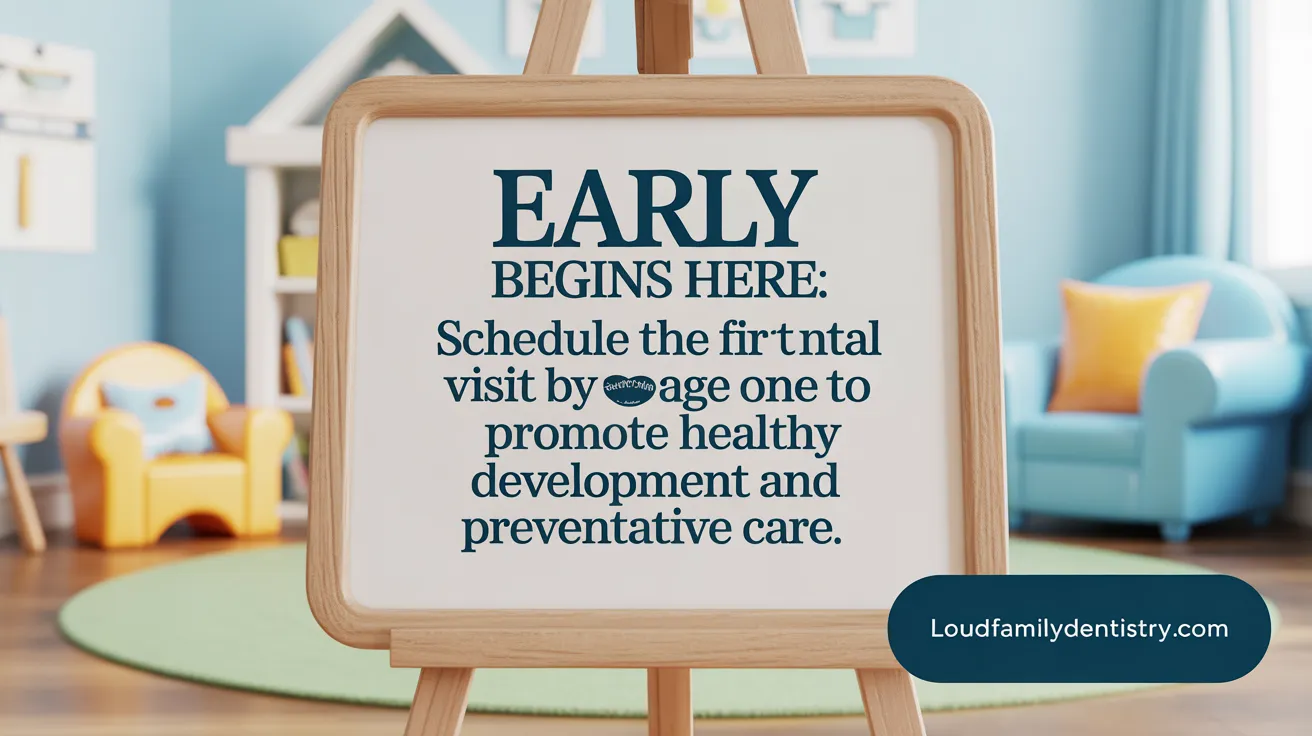
When should a child have their first dental visit according to the American Academy of Pediatric Dentistry (AAPD)?
The American Academy of Pediatric Dentistry (AAPD) recommends that children have their first dental visit by their first birthday or within six months after their first tooth erupts. This early visit is essential to establish a dental home—meaning ongoing, accessible dental care—beginning early in a child's development.
Establishing a dental home early allows for proactive monitoring of the child's oral health, early detection of dental issues, and implementation of preventive strategies. Childhood caries, or tooth decay, is the most common pediatric disease, affecting over half of children in their primary teeth. Early assessment helps address decay risks before they develop into more severe problems.
Moreover, the first dental visit often aligns with important milestones, like the emergence of the first tooth, which usually occurs between 4 and 7 months of age. Waiting until children are older can increase the risk of decay, often resulting in urgent or emergency dental visits. Data shows nearly 70% of children visit a dentist for routine care after age 3, sometimes when untreated decay has already caused pain or infection.
Conducting dental assessments early helps children become familiar with the dental environment, reducing anxiety and fostering positive attitudes toward oral health. During the initial visit, professional cleaning, fluoride treatments, and oral health counseling are common practices.
Parents are encouraged to start good oral hygiene habits before the first tooth erupts, such as gently cleaning gums with a damp cloth and avoiding sugary liquids at bedtime, to prevent early decay.
In summary, scheduling the first dental check-up by age one is critical to promoting lifelong oral health, avoiding costly treatments later, and ensuring children develop healthy habits from the start.
Prevalence and Impact of Dental Caries and Other Oral Diseases in Children
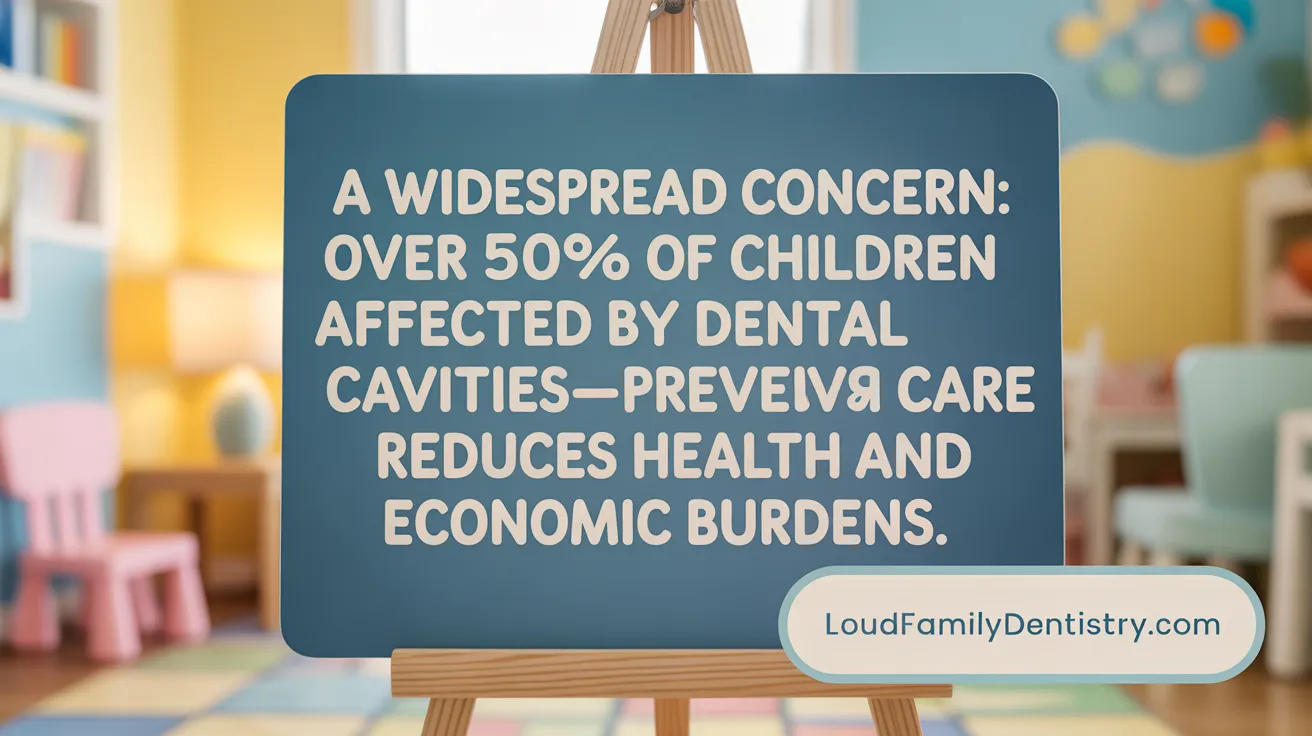
What is the extent of dental caries among children?
Dental caries is the most common chronic disease in childhood, affecting over half of children in their primary teeth. National surveys reveal that more than 50% of young children experience tooth decay, making it four times more prevalent than asthma.
How does childhood dental decay compare with other health issues?
Compared to other childhood illnesses, dental caries is significantly more frequent. For example, asthma affects fewer children, yet dental cavities affect twice as many young children, highlighting its widespread nature.
Are certain groups more affected by dental diseases?
Children living in poverty face a higher burden, with their dental diseases more than twice as likely to remain untreated. This disparity underscores socioeconomic factors influencing oral health.
What happens if dental issues go untreated?
Untreated severe tooth decay can lead to significant health problems, including pain, infection, and even hospitalization. Costs for extensive dental treatment can escalate to as much as $25,000, especially if surgery or anesthesia is needed.
How often do children visit the emergency room for dental problems?
In the United States, dental-related emergency department visits among children reached over 200,000 in 2008 alone. The average cost per visit was around $564, and these numbers are on the rise, signifying a critical need for preventive care.
| Aspect | Data | Additional Insights |
|---|---|---|
| Prevalence of dental decay | Over 50% among children | More common than asthma and other childhood diseases |
| Disparities | Twice as likely untreated in low-income children | Socioeconomic status affects access and care |
| Cost of severe decay | Up to $25,000 | Often involves hospitalization and anesthesia |
| Emergency visits | Over 200,000 in 2008 | Significantly increasing trend |
Early dental care and preventive practices such as fluoride use and routine check-ups are crucial. These measures help reduce the prevalence of decay, prevent emergency visits, and ultimately lower the economic and health burden on children and families.
Factors Influencing Timing of First Dental Visit and Access to Care
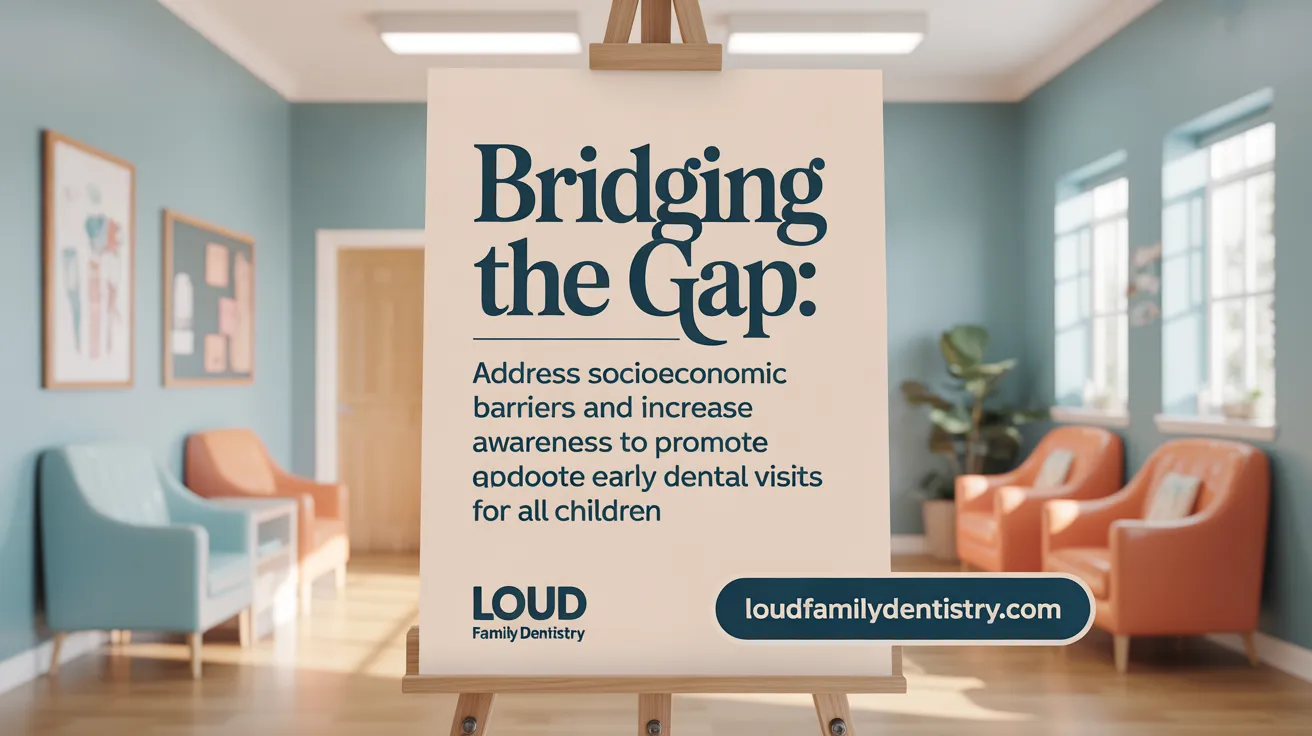
Parental Awareness and Misconceptions
Many parents are unaware of the importance of scheduling their child's first dental visit by age one, often delaying care due to misconceptions about dental health being solely related to dental problems. This delay can increase the risk of developing early childhood caries, which is the most common pediatric disease in the U.S. Yet, most dental problems could be prevented with early intervention. Only about 27% of first visits are for check-ups, highlighting a need for increased parental education on preventive dental care.
Influence of Socioeconomic Status
Children from low-income families face higher rates of untreated dental decay, with their diseases occurring more than twice as often as those from higher-income backgrounds. This disparity is linked to fewer preventive visits and limited access to dental services. Children living in poverty are twice as likely to suffer from cavities before age five, and they often encounter barriers such as transportation, lack of insurance, and limited awareness.
Disparities in Access to Early Dental Care
Significant disparities exist in accessing early dental care. Data reveal that only about 5% of children under age one receive a dental examination, despite guidelines recommending a visit by this age. Children of minority groups and those in underserved regions experience even lower rates of early visits. Emergency visits due to dental issues are common as a result, indicating gaps in preventive care.
Role of Medicaid and Pediatric Dentist Availability
Most pediatric dentists accept Medicaid, which is vital for providing access to vulnerable populations. Nonetheless, the number of specialized providers remains limited, although projections indicate an increase through 2030. Expanding Medicaid coverage and increasing pediatric dentist availability are essential steps to reduce disparities and promote early dental visits.
Impact of Caregiver Education and Medical Home Coordination
Caregivers' understanding of early dental care significantly influences visit timing. Children whose mothers utilized preventive dental care prenatally or had consistent well-baby visits tend to visit the dentist earlier. Coordination between medical providers and dental professionals, especially during well-baby visits, can promote early dental screenings. Promoting this integrated approach helps establish the child's dental home, fostering lifelong oral health.
Demographic Statistics on Dental Visit Timing
Statistics show that most children have their first dental visit between ages 1 and 3. About 52.9% have their initial visit between ages 3 and 5, while only a small fraction—around 5%—are seen before age one. Children over age six are more likely to have annual dental visits. Data also indicate that children with special health care needs are more likely to seek early dental care, but many still experience delays. Improving awareness and access could ensure more children receive preventive care by their first birthday.
Prevention Strategies and Guidelines for Promoting Early Oral Health
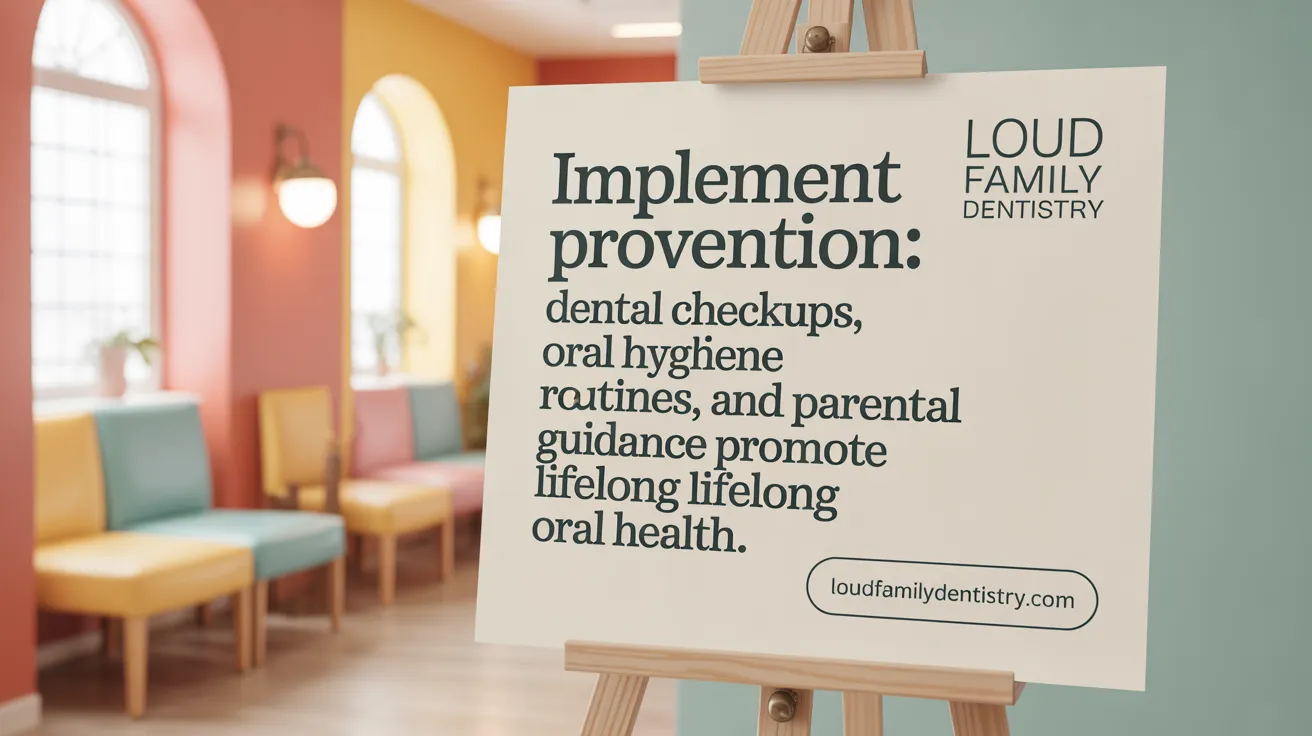
What are the recommended prevention strategies and guidelines for promoting early oral health in children?
Promoting good oral health in children requires a proactive, multi-faceted approach. It begins with educating parents and caregivers about proper oral hygiene practices before and after teeth erupt. Before teeth appear, gently cleaning the baby's gums with a damp cloth helps remove bacteria and establishes a routine of oral care. Once the first tooth emerges, typically between 4 to 7 months, parents should begin brushing with a small, soft toothbrush using a smear or rice-sized amount of fluoride toothpaste.
Establishing a dental home early—by the child's first birthday or within six months of the first tooth—is crucial. This allows for early assessment, preventive care, and education about maintaining oral health. Regular dental visits, typically every six months, enable detection of early signs of dental issues, application of fluoride varnish, and sealant placement to prevent decay.
Diet plays an important role. Limiting frequent intake of sugary foods and beverages, avoiding propped bottles and nighttime feeding with liquids high in sugar, and promoting breastfeeding until at least six months help lower cavity risks. Careful monitoring fluoride exposure, through community water fluoridation or supplements if necessary, helps strengthen enamel.
Supervised toothbrushing with fluoride toothpaste should begin around age two, gradually increasing in amount as child skills develop. Additionally, lifestyle habits such as avoiding prolonged thumb sucking and pacifier use beyond age four are advised to prevent misalignment and developmental issues.
Collaboration between healthcare providers—pediatricians, dentists, and specialists—and parents ensures a comprehensive prevention plan. This teamwork, supported by continuous education and reinforcement, nurtures healthy oral habits that can last a lifetime. Implementing these guidelines minimizes early childhood caries, reduces future treatment costs, and supports overall health development.
Role of Early Oral Health Education for Caregivers and Healthcare Providers
How important is education for caregivers on maintaining children’s oral hygiene and diet?
Educating caregivers about proper oral hygiene practices and healthy dietary habits is crucial in preventing early childhood caries and establishing a foundation for lifelong oral health. Proper routines like brushing with fluoride toothpaste, limiting sugary snacks, and avoiding extended bottle feeding during sleep significantly reduce decay risk.
Why should healthcare providers be trained to offer anticipatory guidance?
Training healthcare professionals to provide anticipatory guidance during routine visits, especially in prenatal and perinatal stages, helps identify early risk factors and promotes preventive measures. This guidance empowers parents before any dental problems develop, encouraging early dental visits and healthy habits.
What is the role of prenatal and perinatal oral health education?
Educating expectant mothers about oral health’s influence on overall prenatal health and the importance of maintaining oral hygiene during pregnancy can prevent early colonization of harmful bacteria in infants. This early guidance supports healthier baby teeth and reduces the likelihood of dental caries.
How can community and school-based programs support early dental health?
Community and school programs serve as vital platforms for promoting oral health awareness, offering preventive services like fluoride varnish applications, and encouraging regular dental visits. These initiatives particularly benefit children from low-income families, helping to bridge gaps in access and knowledge.
What impact does early oral health education have on dental caries and overall outcomes?
Providing early education significantly reduces the incidence of dental caries, decreases emergency dental visits, and lowers treatment costs over time. Children who receive early guidance are more likely to develop positive oral health behaviors, leading to improved dental and overall health outcomes.
Understanding Developmental Milestones and Their Relationship to Oral Health Care
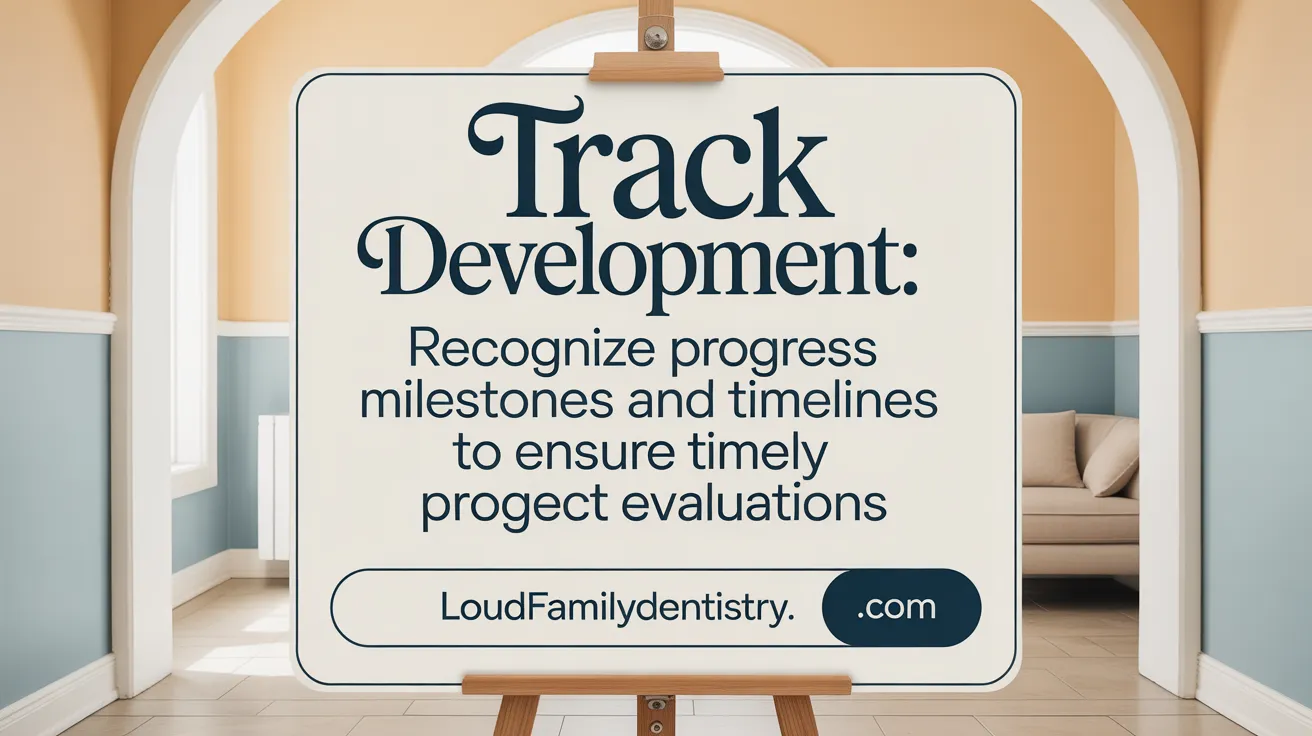
What is the eruption timeline of primary teeth?
The emergence of primary (baby) teeth follows a predictable pattern called the eruption timeline. Typically, children develop their first teeth around 4 to 7 months of age, starting with the lower front teeth. By approximately 15 months, most children will have around 8 teeth, and by 19 months, they usually have 12. By 27 months, all 20 primary teeth are generally erupted. Monitoring this timeline helps caregivers and dentists ensure that oral development proceeds normally.
What is the '7 4 rule' in pediatric dentistry and how does it relate to the eruption of primary teeth?
The '7 4 rule' offers an easy way to remember the expected timing of primary teeth eruption: children typically have their first tooth at 7 months. Then, at approximately 11 months (7 months + 4), they have four teeth. By 15 months, 8 teeth are expected; at 19 months, 12 teeth; at 23 months, 16 teeth; and by about 27 months, all 20 primary teeth should be present. This timeline helps identify early or delayed eruption, prompting timely dental assessment.
What is the 'Rule of 7' in pediatric dentistry?
The 'Rule of 7' recommends that children have their first dental visit by age 7. By this age, they should have lost all primary teeth, and early dental visits serve multiple purposes. Regular checkups help monitor oral development, address habits like thumb-sucking, and prevent problems such as malocclusions. Pediatric dentists provide tailored care, teaching children proper oral hygiene and applying preventive measures like fluoride varnish and sealants. This early involvement promotes long-term oral health and sets positive habits.
At what age can a child typically brush their own teeth?
Most children begin to brush their teeth under supervision around ages 3 to 6. Between ages 6 to 8, they usually develop enough manual dexterity to start brushing independently. Children at this stage can often brush their teeth effectively if guided initially, but parental supervision remains important. By about age 8, most have the capability to brush on their own for the full two minutes needed to clean all surfaces thoroughly. Regular checks by parents ensure proper technique and reinforce good habits.
Why are behavioral aspects during first dental visits important?
Child behavior during initial dental visits is influenced by age, previous experiences, and parental support. Most children behave positively when they are comfortable and well-prepared, with about 67% showing cooperative behavior during their first appointment. Early visits help familiarize children with the dental environment, reducing fear and anxiety. Positive behavior fosters a good relationship with the dentist, making future visits easier and more effective.
How should parents monitor oral development?
Monitoring includes observing the eruption of primary teeth, ensuring good oral hygiene, and watching for signs of dental decay or malocclusion. Regular dental checkups, ideally starting at age one, allow professionals to assess growth and development, provide anticipatory guidance, and address concerns early. Correcting habits like thumb-sucking and prolonged bottle use can also prevent future dental problems.
What guidance exists regarding habits like thumb sucking and bottle use?
Prolonged thumb-sucking and extended bottle feeding, especially during sleep, can impact oral development by causing misalignment, open bites, or other malocclusions. These habits should ideally cease by age 4. Caregivers are encouraged to limit bottle use to water during bedtime and to gradually discourage thumb or pacifier use through positive reinforcement. Early intervention helps ensure normal mouth and jaw growth, reducing future orthodontic needs.
Building a Foundation for Lifelong Oral Health
Early oral health care and timely pediatric dental visits are indispensable for preventing dental diseases, reducing treatment costs, and fostering positive dental experiences in children. The wealth of research and statistical evidence endorses the AAPD and other leading bodies' recommendation for a first dental visit by age one, coinciding with the emergence of the first tooth. Establishing a dental home early allows continuous monitoring, preventive care, and caregiver education, which together contribute to healthier outcomes and decreased disparities. Overcoming barriers to access and enhancing caregiver and provider education remain critical challenges. By adhering to guidelines, promoting preventive strategies, and understanding developmental milestones, families and health professionals can work together to ensure children grow up with strong, healthy smiles and a positive relationship with dental care.
References
- [PDF] The Importance of the Age One Dental Visit - AAPD
- [PDF] State of Little Teeth - AAPD
- Why Early Pediatric Dentistry Matters: Key Facts and Benefits
- Children's dental visits - MN Public Health Data Access Portal
- Your Baby's First Dental Visit: Essential Timing Guide for Parents
- Age of first dental visits: A benefit of the pediatric medical home
- Top 6 Kids' Oral Health Facts - Kids Smiles Pediatric Dentistry
